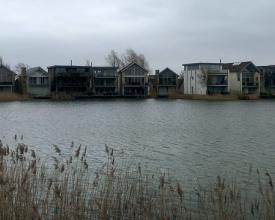
Landscape-led redevelopment of a former quarry to benefit people and wildlife

Lower Mill Estate has been designed as a landscape-led redevelopment of a former quarry, providing up to 575 holiday homes in a green and blue setting in the heart of the Cotswolds. The scheme, which been Awarded an Excellent accreditation from Building with Nature, integrates a network of green infrastructure features which perform varied functionality for people and wildlife, both within the boundary of the scheme and beyond.
The key ecological characteristics of the Estate comprise a rich variety of rivers, tributaries, drainage channels and open water bodies; watercourses lined with riparian vegetation with prominent lines of willows; scattered pattern of woodland copses resulting in a sense of enclosure and an intimate landscape; floristically rich hay meadows and pastoral land use; level land form with wide open skies; and modern waterside development with distinctive architectural style, making the most of building materials which reflect local vernacular.
Context
Challenges addressed
Location
Impacts
To date 310 units have been completed and Mill Village, Copse Mere, Clearwater Village and Howells Mere are now complete. As a Building with Nature accredited scheme, the site will continue to be actively managed by Habitat First Group to maximise its recreational and ecological value.
Building with Nature is the UK’s first benchmark for high-quality green infrastructure and introduces a set of Standards, developed in partnership with industry, that define high-quality Green Infrastructure at each stage of the GI lifecycle, from design, through to implementation, and long-term management. Building with Nature offers formal Accreditation of both physical development and strategic policy documents.
The Building with Nature Standards are free to use, but Accreditation includes a fee for Assessment and Audit. End-users include developers, housebuilders, local authority planners, and a wide range of design and construction professionals.






